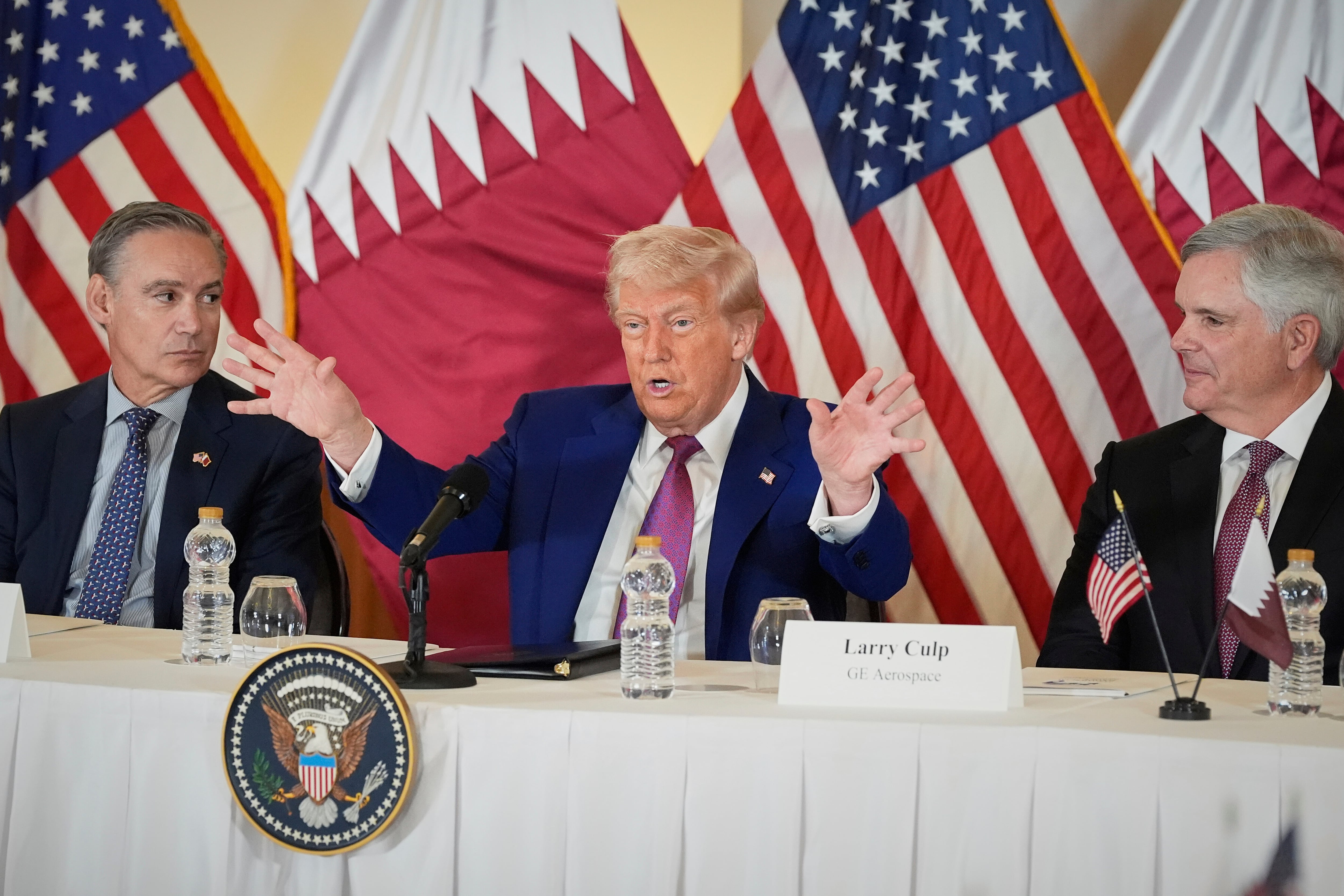President Donald Trump’s comments Thursday in Qatar about future fighter jets planned for the U.S. military have baffled observers and been met with silence from the Pentagon.
During a roundtable discussion in Doha, Qatar, flanked by the heads of Boeing and GE Aerospace, Trump surprised many in the military aviation world by asserting a twin-engined F-35 successor, which he dubbed the F-55, was in the works.
“The F-35, we’re doing an upgrade, a simple upgrade,” Trump said. “But we’re also doing an F-55, I’m going to call it an F-55. And that’s going to be a substantial upgrade. But it’s going to be also with two engines.”
Trump added that a modernized version of the F-22, which he referred to as “F-22 Super,” was in the works.
Frank Kendall, the secretary of the Air Force during former President Joe Biden’s administration, said in an interview with Defense News that it is unclear what Trump was referring to when he discussed an “F-22 Super,” but it may have been a reference to the F-47 sixth-generation fighter jet.
The F-47, which was previously referred to as Next Generation Air Dominance, is intended to replace the service’s fleet of about 185 F-22 Raptors. The Air Force has worked for years on NGAD, and in March awarded Boeing the contract to build them.
But Trump’s F-55 comments came with no additional details, and the government has not provided any further clarity on what he meant.
The Air Force and Navy referred questions about Trump’s comments to the White House. A White House spokesperson contacted by Defense News referred questions to another spokesperson, who did not immediately respond.
Lockheed Martin, which makes both the F-35 and F-22, did not address specific questions about Trump’s comments but issued a statement that read, “We thank President Trump for his support of the F-35 and F-22 and will continue to work closely with the administration to realize its vision for air dominance.”
Kendall said it is also unclear what Trump was referring to when he discussed the alleged F-55.
“President Trump appears to have been speculating out loud about future airplanes that, as far as I know, don’t exist,” Kendall said.
Aviation expert Richard Aboulafia suggested Trump may be “trolling” the public with his suggestion of an F-55 fighter jet. When asked whether he could think of anything that might fit Trump’s reference to an F-55, Aboulafia said, “Other than from Revell model kits from a couple decades ago? No.”
The Navy is working on its own sixth-generation fighter, which it refers to as F/A-XX. It is unclear whether Trump’s F-55 comments may have been in reference to that.
Trump also disparaged the F-35’s single-engine design and suggested that could put the jet at risk if an engine failed.
“An F-35 has a single engine; I don’t like single engines,” Trump said, before gesturing to GE Aerospace chief executive Larry Culp. “Even this man, he’s the best in the world at engines. But on occasion, I know you won’t admit this, if an engine goes out, it’s nice to have two, three or four. That’s why I like the 747, it’s got four.”
Kendall pointed out that the Air Force now flies about 830 F-16s and 471 F-35As, which have single engines, versus the 185 F-22s and more than 250 F-15s that account for its twin-engined jets.
“The bulk of our fighter fleet is single-engine aircraft, and has been for forever,” Kendall said. “Those engines are highly reliable.”
The F-35 program, Lockheed Martin and engine maker Pratt & Whitney are working on a variety of improvements to the Joint Strike Fighter, which Trump may have been referring to when he discussed the jets’ “simple upgrade.”
A series of upgrades called Block 4 are intended to improve the F-35’s sensors, target recognition and electronic warfare capabilities, and allow it to carry more weapons. Lockheed Martin told reporters earlier this year that it planned to start rolling out some early Block 4 capabilities to the F-35 this summer.
Pratt & Whitney is also working on modernizing the F-35’s existing engines with a core upgrade, which is intended to deliver more power, thrust and cooling capability.
Lockheed Martin executives said in an April earnings call they hoped to adapt some sixth-generation technologies, developed as part of their NGAD bid, into the F-35 and F-22. This would create a “supercharged,” “fifth generation-plus” jet, Lockheed chief executive Jim Taiclet said, akin to making an F-35 into a “Ferrari.” Taiclet said this may allow the F-35 to deliver most of the capabilities of an NGAD jet at half the cost.
The intentions behind Trump’s comments about upgrading the F-35 and the F-55, and his preference for a dual-engine jet, were unclear. But Aboulafia said that if Trump was advocating for modifying the F-35 with a pair of engines, that would be virtually impossible short of a massive restructuring of the entire jet.
To do that, he said, Lockheed Martin would have to “rip apart the entire middle of an F-35, [and] replace it with a completely different middle. You should probably get new wings with it … just for stability. … That might be the worst idea ever, but theoretically, sure [it could be done]. It would just be a new aircraft.”
Trump also suggested military aircraft’s stealth capabilities are quickly cracked by potential adversaries and rendered obsolete, and he disparaged the aesthetics that result from a low-observability design.
“Sometimes, you know, stealth, they do stealth,” Trump said. “I’m not a huge believer in stealth, because stealth is basically, a lot of it’s the design and the shape. … You’re going to design an ugly plane for stealth reasons. And then six months later, they’re going to figure out this, and then you’re stuck with a plane.”
Trump’s new stance on stealth differed from remarks he made during his first administration, when he repeatedly extolled the F-35’s stealth capabilities.
“You can’t see it,” Trump said in 2017. “You literally can’t see it. It’s hard to fight a plane you can’t see.”
Top Air Force leaders have not indicated any desire to step away from stealth capabilities. To the contrary, the service has emphasized the need for future combat aircraft to be as undetectable as possible to survive in a potential conflict with China, whose military is nearest in capabilities to the United States.
The upcoming B-21 Raider stealth bomber and F-47 have been designed with advanced stealth capabilities, and the drone wingmen known as collaborative combat aircraft will also use stealth. The Air Force has even considered adding stealth capabilities to a next-generation refueling tanker, to allow it to refuel jets closer to a combat zone, though budget concerns have put those plans in doubt.
The fifth-generation F-22 is also a stealth fighter, which seemed not to have lessened Trump’s enthusiasm for its profile.
“I think the most beautiful fighter jet in the world is the F-22,” Trump said.
Stephen Losey is the air warfare reporter for Defense News. He previously covered leadership and personnel issues at Air Force Times, and the Pentagon, special operations and air warfare at Military.com. He has traveled to the Middle East to cover U.S. Air Force operations.





